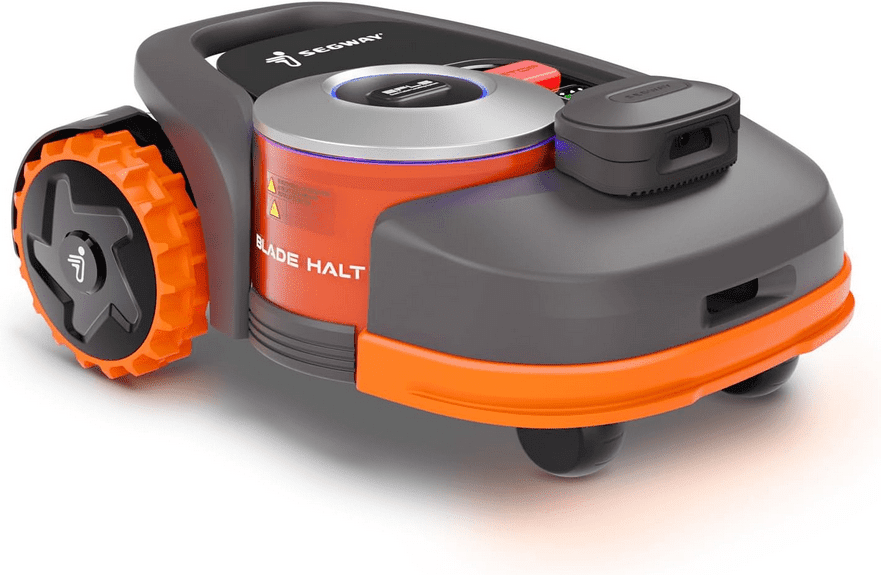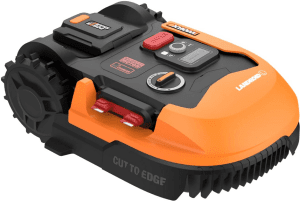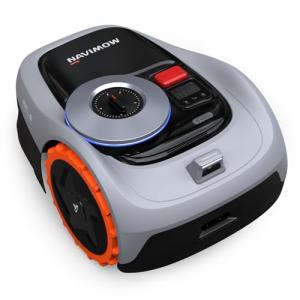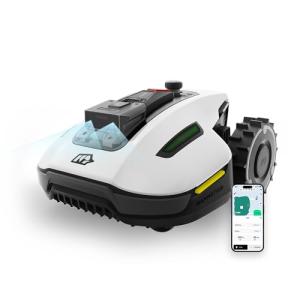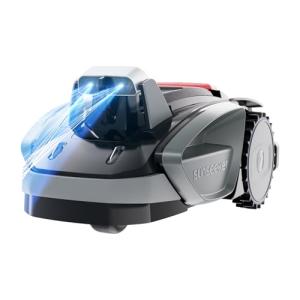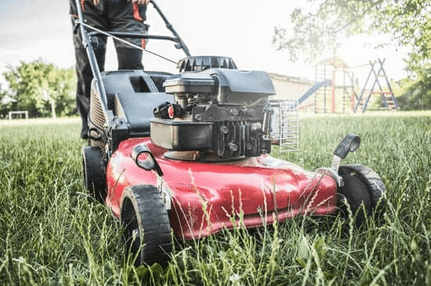Discover if the Segway Navimow H1500N-VF is the perfect robot mower for your yard:
We’ve been testing out the Navimow H1500N-VF, and honestly, it feels like a real leap compared to older robotic mowers. The biggest thing we noticed? No more fussing with perimeter wires.
Setting up a virtual boundary in the app was quicker than we expected. Once it started mowing, the yard looked evenly cut—no weird missed patches.
We like how quietly it runs. It handled our lawn without leaving heavy tracks or ruts.
The app controls are handy for tweaking zones and schedules, though there’s a bit of a learning curve. Setup gets tricky under trees or in spots with weak signals, and it can struggle in bigger yards than the specs claim.
Once you get the mapping right, though, it keeps the grass looking sharp.
Overview: Segway Navimow H1500N-VF Robot Lawn Mower
When we first set it up, defining the mowing area was simple—no wires to bury, finally. Drawing a virtual boundary in the app felt much easier than old-school setups.
Once it got going, the mower followed a steady pattern, and the lawn stayed even. We liked that it could handle small obstacles, like stray garden items, without getting stuck.
The quiet operation meant we could run it during the day without bothering anyone. Mapping the yard took some trial and error, though, and big or oddly shaped spaces needed extra tweaking.
What stood out to us:
- Pros: Wire-free setup, quiet mowing, smart obstacle detection
- Cons: Mapping can be tricky, coverage may feel limited for bigger yards
RTK and Vision Integration
The mower handles positioning better than most wire-free models we’ve tried. The RTK system keeps it on track in open spaces, while the vision sensors help out when the signal drops near trees or fences.
This combo gave us steady mowing without the mower wandering outside its set boundaries. The vision system also helped with obstacle detection, picking up toys and pots so we didn’t have to clear the yard every time.
It did slow down more than we expected in shaded areas, though, so mowing wasn’t always consistent.
Virtual Boundary and Systematic Mowing
We liked not having to bury wires for the mowing area. Using the app to draw a virtual boundary felt pretty straightforward.
Once mapped, the mower stuck to its limits and didn’t wander. It followed a clear path and gave the lawn an even, tidy look instead of random stripes.
The systematic mowing kept the grass consistent. We needed a bit of patience to get the boundaries right, especially around trees or weird edges.
Once we dialed it in, the mower handled zones efficiently and didn’t leave obvious tracks.
Pros:
- No physical wires needed
- Clean, organized mowing pattern
Cons:
- Initial mapping can take patience
- Edges near obstacles may need touch-ups manually
Visual Obstacle Avoidance
Testing the mower around toys, pots, and even a picnic blanket, it did a solid job steering around most things. The built-in camera and sensors made us feel comfortable letting it run unsupervised.
It slowed down when approaching objects, which helped avoid bumps. Flat stuff like mats got detected more reliably than we expected, though very small or low-profile items sometimes slipped through.
Pros we saw:
- Avoids common yard items like balls, pots, and mats
- Moves cautiously near obstacles for added safety
Limitations:
- Struggles with very small objects
- Works best if we tidy the lawn first
Smart App Control and Multi-Zone Management
The app control turned out to be one of our favorite features. Setting up zones was pretty easy, and it let us create different schedules and cutting heights for each area.
This flexibility came in handy for spots with thick grass that needed more frequent mowing. Managing up to 12 zones gave us lots of options, but getting the mapping right took a few tries.
Once we adjusted the boundaries, the mower followed the plan without much babysitting. We liked checking progress and controlling the mower remotely, too.
OTA updates through the app were simple to install and kept everything running smoothly. The initial setup did feel a bit time-consuming if your yard has lots of obstacles.
Ultra-Quiet Operation
Right away, we noticed how little noise it made. It’s about as loud as a normal conversation, so we could go about our day without being distracted.
Even when it worked close to the house, it never felt disruptive. The quiet operation meant we could let it mow early in the morning or late at night without worrying about bugging the neighbors.
That flexibility made it easy to fit mowing into our schedule. There’s still a faint hum if everything else is silent, but it’s not bothersome unless you’re listening for it.
Pros:
- Runs noticeably quieter than gas models
- Comfortable to use at any time of day
Cons:
- Low hum is still present in very quiet settings
Installation and Setup Experience
The setup process was pretty straightforward, but you’ll need a little patience. Since there are no perimeter wires, we relied on the app to draw virtual boundaries.
The app walked us through each step, and mapping got easier after the first try or two. The charging station and antenna required some planning, especially if you have trees interfering with the signal.
Once installed, the mower connected without major issues. Getting the boundaries just right took a few adjustments, though.
Pros we noticed:
- No need to bury perimeter wires
- Clear guidance through the app
Challenges we faced:
- Mapping the yard had a learning curve
- Signal interference around tall trees
Pros and Cons
After spending some time with this mower, we found some clear strengths and a few things we’d like to see improved.
Pros
- Wire-free setup: No need to bury perimeter wires—setting boundaries in the app saved us time and frustration.
- Systematic mowing: The mower followed a consistent path, leaving the lawn looking even and tidy.
- Quiet operation: It ran at a low noise level and didn’t disturb us or the neighbors.
- Obstacle detection: It recognized and avoided common items like flowerpots and toys, which gave us peace of mind.
- App control: We could adjust schedules, manage zones, and check progress from our phones, which was super convenient.
Cons
- Setup learning curve: Mapping the yard took patience, especially around trees or uneven areas.
- Coverage limitations: Although it claims to handle larger spaces, our experience suggests it struggles with bigger or more complex yards.
- Security features: The anti-theft system felt limited—we wish it offered stronger safeguards.
Customer Reviews
Most people seem to agree the mower cuts well once you get it set up. The lack of perimeter wires really stands out as a big plus.
Mapping the yard can take some trial and error. But after that, the results look consistent and neat.
Several reviewers pointed out both strengths and weaknesses:
- Positive notes: Quiet operation, no buried wires, and reliable mowing once the boundaries are set.
- Drawbacks: Setup can be tricky in yards with trees or uneven ground. Coverage may not always match the advertised size, and some folks felt the security features could be better.
Frequently Asked Questions
What are the key features of the Segway Navimow H1500N-VF Robot Lawn Mower?
The biggest advantage is that it doesn’t need perimeter wires. It uses RTK plus vision tech to stay within virtual boundaries, which makes setup way less messy than the old-school wire systems.
It runs quietly at about 54 dB, so it doesn’t disturb us even in the evening. The app control is pretty handy too—you can adjust mowing zones, schedules, and even cutting height right from your phone.
Highlights we found useful:
- Virtual boundary setup through the app
- Systematic mowing pattern for consistent coverage
- Obstacle detection with a built-in vision camera
- Multi-zone management for up to 12 areas
How does the Segway Navimow H1500N-VF compare to Husqvarna models?
When we compared it to Husqvarna robot mowers, Husqvarna still relies on boundary wires, while the Navimow skips that hassle. This makes the Segway model much quicker to install.
Husqvarna models have a longer track record and might handle bigger lawns better, but the Navimow feels more advanced with its navigation tech. We also found the Segway app more intuitive, though Husqvarna’s ecosystem feels more polished in some spots.
Quick comparison:
| Feature | Segway H1500N-VF | Husqvarna Models |
|---|---|---|
| Boundary setup | Virtual (no wires) | Physical wires |
| Navigation | RTK + Vision | GPS + wire |
| App usability | Modern, simple | Established, detailed |
| Noise level | ~54 dB | Varies, often higher |
What are the differences between the Segway Navimow H1500N-VF and other models in the H series?
Within the H series, the main differences are coverage area and included features. The H1500N-VF is made for lawns up to about 0.37 acres, so it sits in the middle of the lineup.
Some smaller H models cover less ground and might not include the same advanced vision features. Larger H models can handle bigger yards but cost more. In our experience, the H1500N-VF feels like a solid pick for medium-sized yards.
What improvements does the Segway Navimow H1500N-VF offer over previous models like the i108e or i105e?
Setup feels smoother with this version compared to the older i-series. The i108e and i105e relied mostly on GPS, which didn’t always work well under trees or near buildings.
The H1500N-VF adds vision-based positioning, so it stays on track even when signals drop. It also mows more systematically, leaving fewer random tracks. The app is more refined too, with better control over zones and mowing schedules.
It’s just more reliable and less frustrating to manage than the older models we’ve tried.
Can the Segway Navimow H1500N-VF handle complex garden layouts?
Yes, but with some limits. We tested it in a yard with trees, flower beds, and uneven edges, and the mower managed these areas pretty well thanks to obstacle detection and multi-zone mapping.
It does take time to fine-tune the map in the app. Once set, it follows the boundaries pretty accurately. Narrow passages or odd shapes can still throw it off sometimes, but overall it handled complexity better than we expected.
What are the maintenance requirements for the Segway Navimow H1500N-VF Robot Lawn Mower?
Maintenance is pretty straightforward, but you do need to pay attention. We clean the blades and the mower’s underside often to stop grass from piling up.
Once the blades get dull, it’s time to swap them out. Luckily, the box comes with spares, so you don’t have to hunt them down.
We monitor the sensors and camera, wiping them down regularly to prevent dirt buildup. For the charging station, it’s best to pick a stable spot.
Honestly, the antenna works best when it’s got a clear shot at the sky. That helps keep the signal strong.
Basic upkeep checklist:
- Clean blades and replace when worn
- Wipe sensors and the camera lens
- Keep the charging station stable and clear
- Update software through the app when prompte
DISCLAIMER
This document is provided for general information purposes only and should not be relied upon as providing legal advice, technical, or specific operational guidance to the reader, whether as to the practices described in the document or the applicable legal requirements and regulations. Lawnfly.com expressly disclaims any responsibility for liability arising from or related to the use or misuse of any information in this document.
